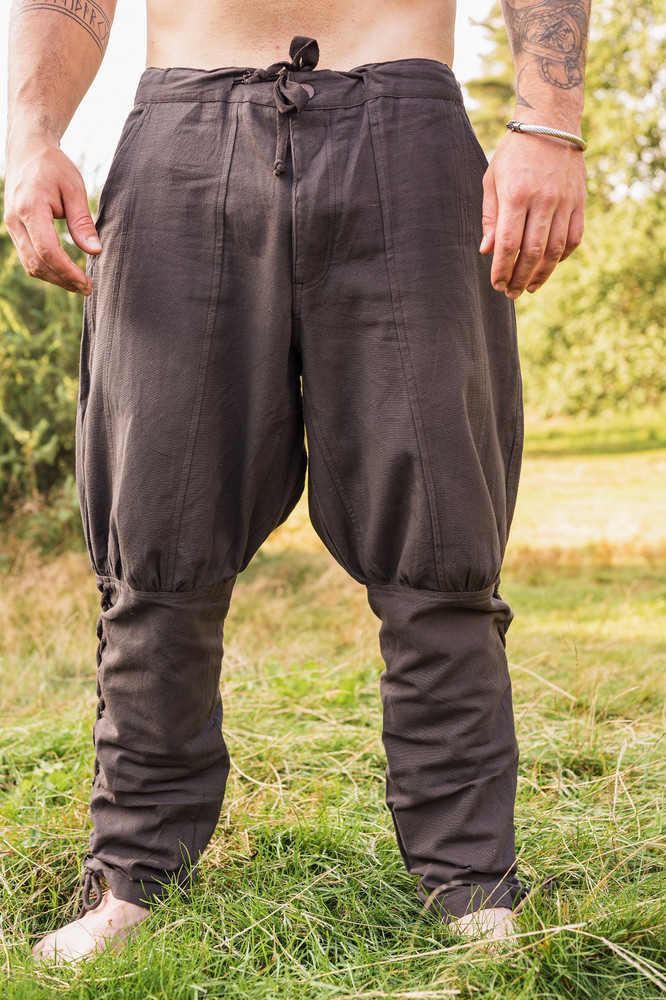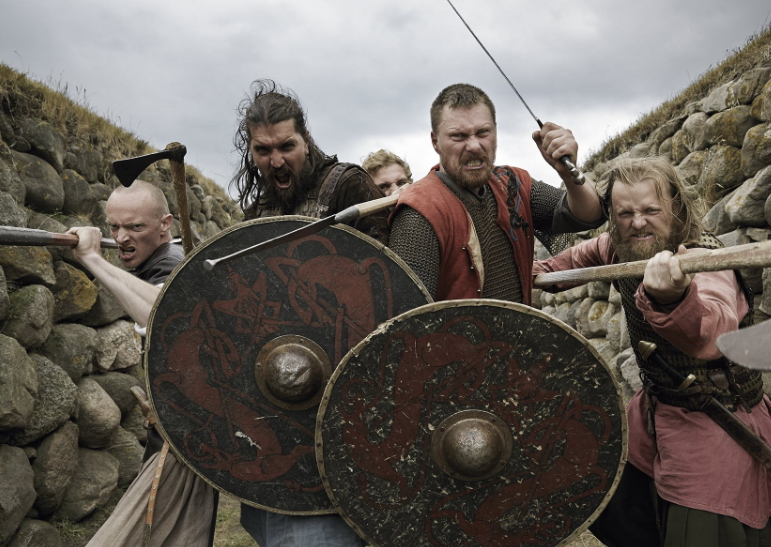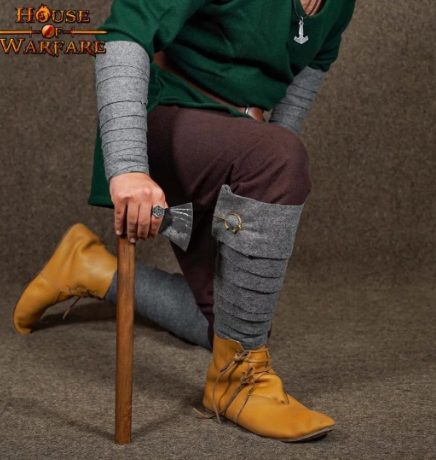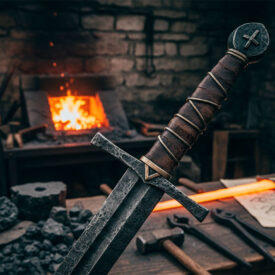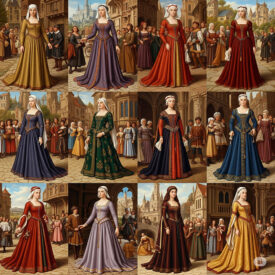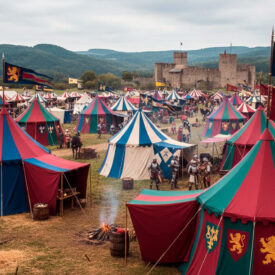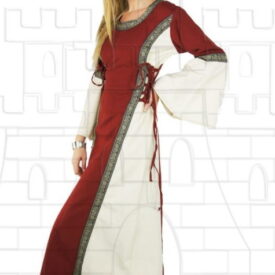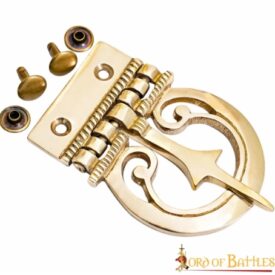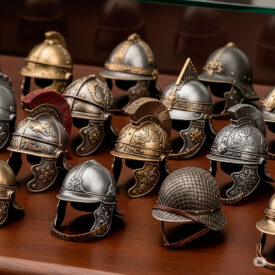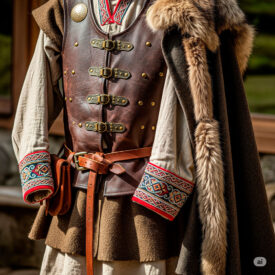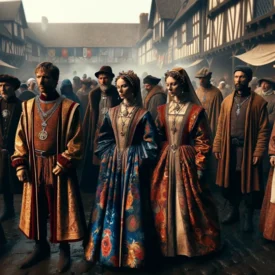Do you imagine Vikings only in coarse furs and dark leathers, heavy armor, and horned helmets? While that image is popular thanks to movies and series, the reality of Viking clothing, and particularly their Viking trousers, was surprisingly different: practical, colorful, and a faithful reflection of their social status and craftsmanship.
Far from being a “new urban tribe” with a biker aesthetic, most Vikings were medieval farmers who valued simple, durable, and, yes, very functional clothing. Attire not only offered protection against the harsh Nordic climate but was also a symbol of identity, wealth, and interconnectedness with other cultures.
In this article, we will delve into the fascinating world of Viking attire, with a special focus on those essential Viking trousers that allowed our Nordic ancestors to move freely, work, and fight.
—
Viking Trousers: Comfort and Durability for Daily Life
Key Materials for Viking Durability
The main materials used for Viking clothing, including trousers, were wool and linen.
- Wool was the preferred option for its durability and warmth, invaluable properties in the cold Scandinavian climate. Viking sheep, primarily white, provided the basis for most of the wool.
- Linen, on the other hand, was often used for lighter garments, especially for underwear, as it was more comfortable on the skin than wool.
Although furs were also used, especially for coats and collars, they were less common for main garments. Silk, a luxury imported from the Byzantine Empire and the East, was reserved only for the wealthiest and was considered a symbol of status.
Construction and Design: Functional Simplicity
Viking trousers were made without pockets or elastic, held at the waist with a simple drawstring or, for those who could afford it, with a leather belt.
There were variations in cut: some were fitted, similar to leggings, while others were looser. Towards the end of the Viking Age, especially in the eastern region (Rus), baggy or flared trousers were seen in the thigh area.
A key element of Viking trousers was the leg wraps (winingas). These long, narrow strips of fabric, usually wool, were wrapped from the ankles to the knees (or even higher), serving to adjust the trousers, provide insulation, and additional protection. They were fastened with fibulae. It is interesting to note that in some regions, such as Iceland, they were not commonly used.
Archaeological Evidence of Viking Trousers
Despite fabric clothing deteriorating easily over time, archaeology, though not having found a complete example of Viking attire, has provided enough fragments for us to have a clear idea of how they dressed. Important finds such as those from the Oseberg ship in Norway or the port of Hedeby in Germany have revealed textile remains of wool and linen, confirming the materials and weaving techniques employed for trousers and other garments. Analysis of these remains has shown that Vikings mastered various weaving techniques, such as tabby, twill, and diamond twill, to produce durable and functional fabrics.
Want to see how these fascinating trousers looked? Explore the authentic options available: Viking trousers
—
Viking Clothing in General: Beyond Trousers
The Art of Color in the Viking Age
Contrary to the popular belief that their clothes were gray and boring, Vikings dressed in vibrant colors. While dyes faded quickly, there is evidence of reds, blues, and yellows, which could be combined to create greens.
- Blue, obtained from woad (Isatis tinctoria), was the most popular and widespread color in Scandinavia. Vikings even used it for their underwear, suggesting it was not excessively expensive.
- Red, from madder (Rubia tinctorum), was more expensive and often imported from places like Germany or France.
- Other colors included orange (from hedge bedstraw), and various shades of yellow (from heather, scentless mayweed, and tansy). The intensity of the color usually indicated the wealth of the wearer.
Viking Male Attire
Viking men wore several layers to keep warm. Their basic attire consisted of:
- Underwear (tunic and trousers), generally made of linen, without colors or patterns, as they were not visible.
- A tunic (Kyrtill) as an outer garment, reaching to the knees. It had sleeves (long in winter, short in summer) and was pulled over the head, without buttons.
- Rectangular capes or cloaks of wool or linen, often thick and heavy, fastened to the right shoulder with a fibula or brooch, leaving the dominant hand free. These capes not only provided warmth but could also indicate status and conceal weapons.
- Men also wore a leather belt (about 2 cm wide, much narrower than modern ones) with often highly decorated buckles. From this belt hung bags (for coins and small tools), knives, and axes.
Viking Female Attire
Women’s clothing was also made from wool and linen. The most common attire included:
- A long inner shirt of linen or wool, reaching to the ankles.
- A sleeveless wool overdress (Hangerock or apron dress), worn over the inner dress. It was fastened at the shoulders with two brooches (often oval or turtle-shaped), which were not only functional but also symbols of wealth and status.
- Between the brooches, women often hung beads, amber, or other jewelry, as well as useful items such as keys, needles, scissors, or a whetstone.
- To protect themselves from the cold, they also wore capes or shawls.
- Like men, they wore a leather belt with a pouch and a knife.
- Some women, especially married ones, wore headscarves or veils, which could be simple for daily wear or richly decorated for special occasions, indicating their marital status and social standing.
A curious detail is that the trefoil brooch, which was originally a masculine accessory for warriors, transformed into a piece of women’s fashion during the Viking Age.
Viking Footwear: The Importance of Leather
Vikings mainly wore leather shoes and boots, designed to be durable and practical. They were often made from a single piece of leather, using a technique known as “turnshoe technique” which made them waterproof. They were treated with grease or oil to keep the leather flexible and water-repellent.
There were low models for daily use and higher boots for long journeys, some even with a kind of “profiled sole” for better grip. In winter, shoes were lined with fur or wool, or even straw or moss was used as thermal insulation. Shoes were fastened with laces or buttons. Heeled boots, although rare, were likely worn by merchants or the upper class.
Jewelry and Accessories: More Than Just Adornment
Viking jewelry was very important, serving aesthetic, practical, symbolic functions, and even as a means of payment.
- Fibulae and brooches were the main means of fastening clothing, also serving as symbols of wealth, status, and religion.
- Necklaces and neck rings (torcs): solid metal neck rings were often used as currency.
- Amulets and pendants: Thor’s Hammer (Mjolnir) was, by far, the most popular amulet design, offering protection and support. Other symbols included the Helm of Awe (Aegishjalmur), the Nordic Compass (Vegvisir), the Tree of Life (Yggdrasil), Odin’s ravens (Huginn and Muninn), Odin’s Spear (Gungnir), and representations of Thor or Odin.
Jewelry was made from iron, copper, bronze, silver (the most common), gold, stones, wood, leather, cotton, and horns. Social class determined the material: the wealthy used bronze, silver, gold, pearls, and precious stones; the poorer, common metals, amber, or glass.
It is important to note that Vikings did not wear earrings.
—
The Reconstruction of Viking Clothing Today
Today, historically accurate reconstruction of Viking clothing is crucial for authentically understanding their culture. Archaeological finds and literary descriptions allow us to paint a detailed picture of their fashion. Modern Viking clothing, while adapted to current lifestyles, maintains an emphasis on functionality and comfort.
By exploring these outfits, we not only connect with a rich cultural heritage but also appreciate the art, craftsmanship, and adaptability of a civilization that left an indelible mark on history. Viking clothing was, in short, a complex and multifaceted reflection of their society.
Don’t miss the best selection of authentic Viking trousers for your next adventure or historical reenactment. Discover the comfort and durability of Norse fashion!
See all Viking Trousers
See Viking Shirts
